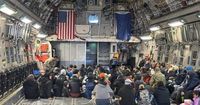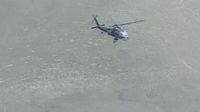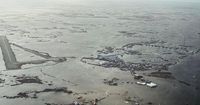On the evening of October 15, 2025, the remote Western Alaska villages of Kipnuk and Kwigillingok found themselves at the center of one of the largest airlift evacuations in recent state history. After a catastrophic storm—formerly Typhoon Halong—swept through the Yukon-Kuskokwim region the previous weekend, these close-knit Yup’ik communities faced devastation on an unprecedented scale. With homes destroyed, basic services crippled, and another storm looming, hundreds of residents were told to pack what they could carry and evacuate, leaving behind not just their belongings, but the only way of life many had ever known.
The mass evacuation began in earnest on October 15, when the first 300 evacuees boarded a C-17 military transport plane in Bethel, bound for Anchorage and the promise of emergency shelter. According to the Alaska Beacon, Jody Agimuk of Kipnuk, who waited in line with his wife Kristin and their five young children, summed up the mood: “Just devastated, feeling heartbroken, displaced.” Despite the uncertainty, Agimuk expressed hope for the future, adding, “I hope we find a place. It’s hard to explain, I hope we won’t have a hard time finding a place.”
The scale of the exodus was staggering. By the end of Wednesday, about 500 people had already been evacuated to Bethel from Kipnuk and Kwigillingok, with more scheduled to leave in the following days. Lieutenant Colonel Brendan Holbrook, commander of the 207th Aviation Troop Command with the Alaska Army National Guard, described the operation: “I have five aircraft, four UH-60s and CH-47 in support operations, doing evac. And we’ve been running basically 12 to 14-hour operations every day getting these people to safety.” Holbrook added that the evacuation was largely self-organized by community members, with families with children and elders given priority.
Conditions in the villages had rapidly deteriorated since the storm struck on October 12. According to the Anchorage Daily News, nearly all homes in both towns were damaged or destroyed, forcing about 1,000 people to seek refuge in local schools. But even those makeshift shelters became untenable as toilets failed, heating fuel dwindled, and power and telecommunications faltered. “It’s unsafe to stay,” said Kipnuk tribal administrator Buggy Carl in an interview with Alaska Public Media. “Right now, just trying to convince everybody to go before the next storm hits.”
Carl’s own experience during the storm was harrowing. He recounted to reporters how his house, with 14 family members inside, began to drift in the middle of the night as surging waters lifted it from its foundation. “We only floated down a few minutes. It felt like hours, because the time was really slow,” he said. “My adrenaline was like out of the roof.” The house traveled half a mile before coming to rest, a testament to the storm’s ferocity.
Despite the danger, not everyone was ready to leave. Deep ties to the land and a subsistence lifestyle made the decision agonizing for many. “I know their mindset, that their heart is here,” Carl said. “They don't know anywhere else to go.” For some, the hope of returning to help rebuild or continue traditional hunting and harvesting was a powerful pull. Others, like Kwigillingok tribal court administrator Brea Paul, were simply unsure of their next steps: “We’re going to be one of the last families to leave so we can let the ones with no homes go first. But as of right now, we don't know where we're gonna go. We don't know what to do.”
The logistical challenge of moving so many people—many of whom had never left their villages—was immense. The Alaska National Guard, working alongside the Alaska Air National Guard, tribal organizations, and the Yukon-Kuskokwim Health Corporation, coordinated a complex airlift using helicopters, private planes, and the massive C-17 Globemaster III. Some evacuees were first taken to the Bethel Armory, which quickly reached capacity, before being flown on to Anchorage’s Joint Base Elmendorf-Richardson and the Alaska Airlines Center arena, where the American Red Cross and University of Alaska Anchorage had set up emergency shelters with beds, food, and medical care.
The human toll of the storm extended beyond displacement. In Kwigillingok, the storm claimed at least one life and left two people missing after their house broke loose and floated toward the Bering Sea during record tidal surges. Alaska State Troopers reported that the body of 67-year-old Ella Mae Kashatok was recovered, while Vernon Pavil, 71, and Chester Kashatok, 41, remained missing. The search, which spanned roughly 88 square miles, was suspended for active military aircraft on October 14, though local volunteers and public safety officers continued recovery efforts using drag bars and sonar equipment.
As the evacuation continued, state officials stressed that while no mandatory evacuation order had been issued, the request for full evacuation came directly from the communities themselves. Jeremy Zidek, spokesperson for the Alaska Division of Homeland Security and Emergency Management, told the Anchorage Daily News, “Kipnuk and Kwigillingok have asked the state and the Alaska National Guard to support a full evacuation of both communities.” The urgency was compounded by forecasts of another, albeit weaker, storm expected to hit the region by late Wednesday night.
Beyond the immediate crisis, the operation also revealed the deep sense of loss and disruption felt by residents. Jacqui Lang, a teacher at Chief Paul Memorial School in Kipnuk, described the heartbreak: “People are devastated. They don’t want to leave.” Many had to abandon pets and almost all their belongings, as evacuation “is no longer optional,” Lang said. Efforts were underway to rescue stranded animals, with local groups and private pilots helping to transport pets to safety in Bethel and beyond.
Support poured in from across the state and the nation. The American Red Cross brought in additional staff to Anchorage and Bethel, while World Central Kitchen coordinated meals for survivors. The Salvation Army and other organizations helped manage donations and sheltering needs. State emergency officials reported mutual aid from Colorado, Virginia, South Carolina, Texas, and Arkansas, underscoring the nationwide response to the disaster.
For those who did not board the first flights out, the Yukon-Kuskokwim Health Corporation and the American Red Cross provided cots, showers, and meals in Bethel, with support to travel to other villages or family if desired. As Lieutenant Colonel Holbrook explained, “If you have a place to go, another village, family, somewhere else, Y-K will help you get to where you need to go.”
The road ahead remains uncertain for many evacuees. State officials are working to make less-damaged homes habitable before winter sets in, but for now, hundreds of Alaskans are left hoping for a swift return to normalcy. As Buggy Carl poignantly reminded everyone, “So many tears. Just crying their eyes out. I understand their pain and frustration, but this is for their own safety.”
The evacuation of Kipnuk and Kwigillingok stands as a stark reminder of the vulnerability—and resilience—of Alaska’s rural communities in the face of nature’s fury. As families settle into temporary shelters far from home, the hope persists that, one day soon, they’ll be able to return and rebuild.







